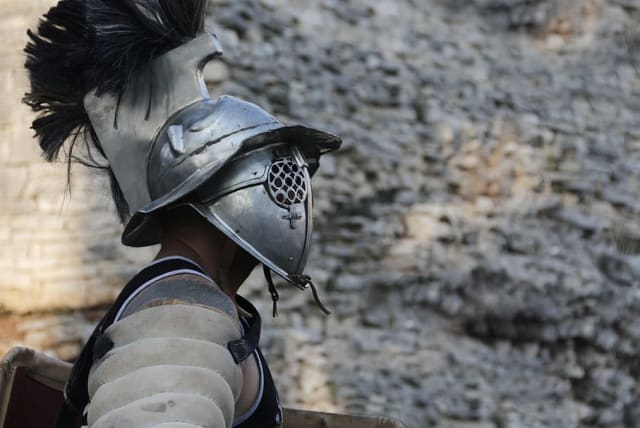Were there Jewish gladiators in the Roman Empire?

A new scholarly article examines the historical evidence of Jewish participation in the gladiatorial arena.
Being a gladiator – an armed combatant who entertained audiences in the Roman Republic and Roman Empire in violent confrontations involving pagan rituals and confronting other gladiators, condemned criminals, and wild animals – would not seem to be a suitable profession for a nice Jewish boy.
In fact, most of those who were in the arena were not muscle-bound Arnold Schwartzeneggers but scrawny slaves forced to go into battle. Gladiator games lasted for nearly 1,000 years, reaching their highest point between the 1st century BCE and the 2nd century CE before their disappearance.
In the past, it has been suggested that Jews were both participants and spectators in the gladiatorial games. Yet, all the materials presented to prove the existence of Jewish gladiators seem to be less conclusive than what the authors deem them to be.
A new article published online in Atiqot, a journal published by the Israel Antiquities Authority entitled “Were There Jewish Gladiators? A Re-Evaluation of the Available Archaeological and Textual Evidence,” was written by Dr. Haggai Olshanetsky who has studied Jewish participation in the ancient Roman army. The author, who studied at Bar-Ilan University (BIU) in Ramat Gan, is currently doing post-doctoral research in the ancient civilizations department at the University of Basel in Switzerland.
“The participation of Jews in the arena, especially as gladiators, has received relatively little attention. The few articles written on this matter suggest that Jews were both spectators and participants,” he wrote. “The present paper relates to all previously suggested indications for the existence of Jewish gladiators and also introduces new ones. Although the possibility that Jewish gladiators were active in the 1st to the 4th centuries CE cannot be ruled out entirely, the evidence remains inconclusive, suggesting that their number was very limited at best.”
Jewish roles in arena combat
It is also suggested that if Jews had participated in the games, they possibly preferred to fight beasts rather than men. The arena and the performances therein were an integral part of daily life in a Roman city in most parts of the Empire. The most famous spectacle occurring in the arena being the gladiatorial games, he continued. However, some Jews wanted to assimilate into Roman society, so they tried to participate in almost all aspects of life there,” said Olshanetsky.
It was true not only for the Roman period, “as Jews comprised a significant percentage of the population throughout the Roman Empire, [but] the question whether Jews took part in the games and even fought as gladiators is an appealing and obvious one and has been touched upon in the past.”
The number of Jews living during the Roman period has been estimated at between 4.5 to seven million. The existence of Jewish gladiators has previously been suggested, especially in the region of Judea. Under Titus, Jews were forced into fighting with wild beasts. The Jerusalem Talmud forbids taking part in and watching gladiatorial matches and refers to one man who attended a match in a stadium as a “shedder of blood.”
Olshanetsky’s paper encompasses all the available archaeological and textual evidence pertaining to the role of Jews in the arena, both as gladiators and in other capacities. The full scale of the Jewish gladiator phenomenon is explored by the author in an examination of the different finds, some of which were discussed in the past and some new.
His central question was whether such a phenomenon ever existed and, if so, how common was it? To examine and fully answer this question, he presents the difference between gladiators and men condemned to death in the arena. He presented various arguments supporting and negating the idea of Jewish gladiators, including the service of Jews in the Roman army in the context of the Jewish community’s attitude toward fighting and spilling blood in and out of the arena.
He believed that while Jews were less keen to fight other men as gladiators, they had fewer qualms fighting beasts. “It is clear from the text that there were two different groups in the arena… The first group comprised people deemed to be put to death for entertainment purposes – these were not gladiators, but as they came from territories under King Herod’s control, they may have been Jews, but during his reign, games were held in cities where Jews were a minority.”
The second group were gladiators, who traveled from afar in the name of fortune and glory. “The fact that they came from all over the empire suggests that they were not necessarily Jewish. The role of both groups was to entertain the masses; but the difference between these two classes in the arena is essential. The men of the first group belonged to the margins of society – punished slaves, prisoners of war, and criminals condemned to death – whose brutal demise was meant to amuse the public.”
The life of a gladiator was considered expensive due to their long and costly training, making it in the best interest of their masters to preserve their lives, so a gladiator would have been proud of his profession, and it seems that a large number of free men volunteered to fight in the arena, with their numbers rapidly growing, reaching a peak in the Late Republic and Early Imperial Period,” the author wrote.
“The gladiators received a nutritious and mainly vegetarian diet, as well as supplements that provided calcium to strengthen their bones and prevent them from breaking. One theory is that this diet enabled the gladiators to maintain a healthy layer of fat, which assisted in preventing life-threatening injuries and merely allowed for bloody, superficial injuries that made the spectacle more appealing to the audience. A different suggestion is that this diet, for which the gladiators were known even in antiquity, was given to them for economic reasons.
A vegetarian diet was significantly cheaper than a meat-rich diet. Yet, the absence of large portions of meat from a gladiator’s diet did not prevent them from having a lean physique, as they burned carbohydrates while training and, therefore, developed muscles and a body akin to current vegan and vegetarian athletes.”
Jerusalem Post Store
`; document.getElementById("linkPremium").innerHTML = cont; var divWithLink = document.getElementById("premium-link"); if (divWithLink !== null && divWithLink !== 'undefined') { divWithLink.style.border = "solid 1px #cb0f3e"; divWithLink.style.textAlign = "center"; divWithLink.style.marginBottom = "15px"; divWithLink.style.marginTop = "15px"; divWithLink.style.width = "100%"; divWithLink.style.backgroundColor = "#122952"; divWithLink.style.color = "#ffffff"; divWithLink.style.lineHeight = "1.5"; } } (function (v, i) { });

